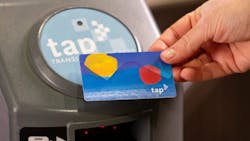L.A. Metro expands TAP-to-Exit program to Union Station
The Los Angeles County Metropolitan Transportation Authority (L.A. Metro) has expanded its TAP-to-Exit program to Union Station (B/D Lines). L.A. Metro notes turnstiles at Union Station will be latched at both the entrances and exits to the rail lines, so riders will need to tap their TAP card or scan their valid Metrolink fare to enter and exit the station.
L.A. Metro began informing riders about the expanded program on Feb. 11 via signage at Union Station and the distribution of brochures, both available in English and Spanish. On Feb. 18, Metro Ambassadors and TAP Blue Shirts will be on-site to assist passengers with loading their fares while representatives from the agency’s Low Income Fare is Easy (LIFE) program will help enroll income-qualified riders. The education period will last through Feb. 25, after which security and law enforcement officers will begin issuing citations for those who do not have valid fares.
The agency is expanding the TAP-to-Exit program as part of its ongoing public safety effort. L.A. Metro says controlling access to the system helps to ensure that people are using the system for their transportation needs and is just one of the ways the agency is working to improve safety. Since 2024, L.A. Metro has been deploying more security officers and contracted law enforcement partners to increase the visibility of uniformed law enforcement officers on the system, as well as upgrading camera technology and lighting at the stations.
The TAP-to-Exit program was first launched at the North Hollywood B Line Station in May 2024, followed by the Downtown Santa Monica E Line Station in September 2024. The agency notes the program has received positive feedback from riders, as the North Hollywood station pilot transformed behavior along the 14 B Line stations, with reported crime and other issues (fights, drug use and graffiti) having dropped by more than 40 percent on the Transit Watch app.
The agency says that in a survey of North Hollywood riders, 90 percent stated the pilot made the station feel cleaner, and 86 percent stated the pilot made them feel safer. Following the expansion to Downtown Santa Monica, Transit Watch incidents dropped 55 percent on the E Line when TAP-to Exit was paired with fare enforcement.
L.A. Metro notes the TAP-to-Exit pilot is an effective, common fare compliance practice around the world and in major transit systems across the U.S. including Bay Area Rapid Transit, Washington Metropolitan Area Transit Authority and the Metropolitan-Atlanta Regional Transit Authority.
The agency says data from its three contracted law enforcement partners revealed that up to 94 percent of individuals arrested on the system for violent crime do not possess valid fare or even a TAP card, which is required to ride on L.A. Metro trains and buses. By expanding the TAP-to-Exit program, L.A. Metro aims to prevent unauthorized use and maintain a safe environment for everyone.
Since TAP-to-Exit was implemented, L.A. Metro notes the program has automatically corrected nearly 120,000 unpaid passenger exits, translating to over $130,000 in fares recuperated alone. The agency has several programs that support making it more affordable for all riders. Reduced-price transit passes, such as the student GoPass, which offers free transit passes to K-12 and community college students, and the LIFE program, which provides free rides and reduced fares to low-income customers, are increasingly helping these qualified riders.
L.A. Metro continues to offer a fare capping program under which riders who pay with a TAP card pay no more $5 a day or $18 over seven days. Once they’ve reached those limits, they ride free for the remainder of the day or seven-day period.
The agency’s Mobility Wallet Pilot Program provides in-need Angelenos the freedom to choose the mode that best suits their needs by providing a debit card with $150 per month to spend on transportation. The card can be used to take the bus, ride the train, use bike share, take Metro-Micro and more.
